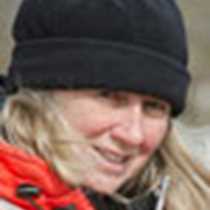Palmer Station, Antarctica
What would it be like to wake up every morning and look out across a sloping plane of ice stretching away to distant mountain peaks? During the night the glacier roars, tossing fragments of itself into the sea, leaving a crystalline flotilla that glimmers like jewels in the low angle light. Its face is scarred with blue wrinkles. Cracks and crevasses add angular lines. The sea is dark except for bergs gleaming white. The sun gathers its light on tiny Torgersen Island, one of several islets scattered nearby. Along its rocky spine orange Xanthoria lichens add color to the scene. And thus began the day at Palmer Station, an inconspicuous set of blue buildings clustered on the rocky shore of Arthur Harbour.
What started out as a well planned visit to civilization however, turned out to be an adventure of sorts. For days satellites had bounced weather maps to our bridge, each promising the arrival of impressive winds. For days we waited and prepared. The barometer gradually dropped, then plummeted and within an hour our tranquil scene had been stirred into a cauldron. Like explorers of days gone by, we simply adapted. More layers of clothes were bundled on and topped with a waterproofed coating. Zodiacs splashed from here to there ferrying from base to ship to Torgersen Island.
At the station, the human community went busily about their tasks while we observed and questioned. On Torgersen Island, the Adélie penguin colony did the same. Both populations have a goal to be attained in the brief Antarctic summer. Researchers must gather data while support staff ensures their health and safety. The birds must raise their young, then molt in preparation for the winter snows.
A full force eight gale greeted us as we turned east into Bismarck Strait. Green patches appeared on the water’s surface between the cresting waves. Finer white streaks run perpendicular joining crest and trough. Clouds clung to the mountain sides but we were warm and comfortable inside.
Paradise Bay is a bite on the western side of the Antarctic Peninsula, its perimeter protected by high mountain peaks that seem to overflow with massive glaciers. Here, the wind still blew but the seas no longer churned. Two countries maintain bases within the protection of the bay. Unlike the camouflaging colors of the Palmer Station, Chile and Argentina have chosen the brilliant shades of the prevalent orange lichens. But it is not the human presence here that attracts our attention. It is the impressive rivers of ice pouring to the water’s edge that quietly wait to demonstrate their power. That force was amply proven as evening drew nigh. Suddenly thousands of tons of ice broke lose crashing into the sea, sending spray a hundred feet into the air. Bus sized bergs rushed out in a semi-circle borne upon a good sized wave.
Day is never ending here. We head back to the Gerlache Strait wondering what the weather will bring for tomorrow.




